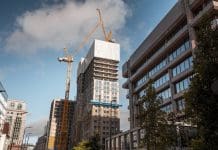The introduction of the new BSR is poised to revolutionise building standards. Established under the Building Safety Act 2022, the BSR is a distinct entity within the HSE, focusing on high-risk residential buildings. John Flathers and Richard Adams, Freeths, explore the legal and compliance implications
The introduction of the new Building Safety Regulator (BSR) should have a profound influence on building standards.
Brought into law in 2022, the body is effectively a sub-division of the existing Health & Safety Executive (HSE) but has a very distinct role to play within the organisation, one which many say was previously lacking.
The BSR will implement a more stringent regulatory framework around higher-risk buildings
Its main purpose will be to implement the new, more stringent regulatory framework around higher-risk buildings.
The BSR will oversee high-risk residential buildings, which are defined in the legislation as those with at least seven floors or 18 metres in height and at least two residential units.
Although the final report in Phase 2 of the Grenfell Tower Inquiry has yet to be published (and has been delayed once more), it is already self-evident that this specialist regulator was needed to ensure tighter controls of multiple-occupancy buildings to avoid such tragedies happening in the future.
Care homes and hospitals also fall under the BSR
Another aspect of the BSR’s work will be the design and construction phases of care homes and hospitals, which have also been concerning in recent years.
With extensive experience representing clients who are investigated and/or prosecuted by the HSE, we know that they are aggressive regulators. Given the background to its creation, the expectation is that the BSR will be no different, potentially even more prepared to take enforcement action.
Indeed, at the Building Safety Conference in 2023, the then Chief Inspector of Buildings, Peter Baker, introduced the BSR as a ‘regulator with teeth’.
Now that the Building Safety Act 2022 has been passed into law, it is only a matter of time before the BSR starts to flex its extensive enforcement powers against dutyholders.
Its mission is to ensure that residents are safe where they live. After all of the preceding controversies, UK government ministers created it to restore confidence in the safety and standards of all buildings as part of a push to drive positive cultural change in the built environment industry.
The ‘Making Buildings Safer’ campaign
Behind the new regulator is the government’s Making Buildings Safer campaign, so it can be inferred that the BSR will be resolutely committed to achieving that aim.
The new building safety regime has introduced significant changes to the building control process. At Gateway 1, when the developer applies for planning permission, they must include a fire statement setting out the fire safety considerations specific to that project.
At Gateway 2, the client must make a building control approval application to the BSR, and that must be approved before building work can commence. The BSR aims to respond within 12 weeks but can request more time if required for inspectors to thoroughly analyse the proposed construction.
The potential for additional delays before building work can commence is undoubtedly a prospect that developers will be dreading. If certain changes subsequently occur to the design, following BSR approval, they will need to be managed through what is known as a ‘Change Control’ process.
A ‘notifiable’ change—one that affects compliance with building approval—can only be implemented once this notice has been given to the BSR.
For major changes, a revised application must be prepared and approved by the BSR, potentially leading to further delays in the construction process. Even after the works to the high-risk building are finished, an application must then be made to the BSR for a completion certificate, requiring the client’s input.
That process is expected to be incredibly thorough, with the BSR having eight weeks in which to consider the application and inspect the building. Only after the BSR has issued a completion certificate, and the principal accountable person has registered the building with the BSR, can it finally be occupied.
Another new requirement is Mandatory Occurrence Reporting, which shares some similarities with the RIDDOR reporting obligations in health and safety matters.
The primary duty holders, for example, the principal contractor and/or principal designer, are now required to notify the BSR of certain safety occurrences (defined in the legislation) within 10 days of them becoming aware of the occurrence during the construction phase of a high-rise building.
These can include events relating to the structural integrity or fire safety of the building. Subject to the nature and severity of the safety occurrence, this could well lead to a change control application, which may delay the project further.
Crucially, under the new regulator’s powers, failure to make a report is a criminal offence punishable by a fine. That reporting obligation passes on to the Principal Accountable Person on occupation.
Powers will be transferred to registered building control approvers
Another significant change is the transfer of building control functions from approved inspectors to registered building control approvers and the introduction of registered building inspectors.
Such is the seismic impact of these changes on a sector that has remained the same for decades that it has provoked fears in the construction industry of a potential staffing crisis.
In response, the BSR has introduced transitional arrangements for the registration of building inspectors in England. Those inspectors who registered with the BSR by the 6 April deadline will now be afforded a further 13 weeks (to 6 July 2024) in which to complete their competency assessment if they are to continue to operate in this industry.
Finally, while not directly attributable to the introduction of the BSA, on 29 March, the UK government published a technical guidance document setting out long-awaited changes to Approved Document B, making second staircases mandatory in all new residential buildings over 18m in England from 30 September 2026.
Developers have 30 months from guidance publication to meet new requirements
Developers will have a 30-month transitional period from the publication of the guidance to comply with the new requirements.
During this transitional period, new building regulations applications can conform to either the previous guidance or the updated guidance requiring a second staircase.
However, when those 30 months have elapsed, all applications will need to conform to the new guidance, meaning second staircases will be compulsory.
The government’s initial proposal was to make this a requirement for buildings over 30m, but the threshold has been reduced so it is consistent with buildings categorised as high risk under the BSA 2022.
Dame Judith Hackitt, who led the review following Grenfell, concluded that a radical overhaul was needed of the built environment culture, which displayed complacency, a lack of competence, and little or inadequate oversight.
The BSA, without doubt, marks the most significant overhaul of the built industry in many years.

















